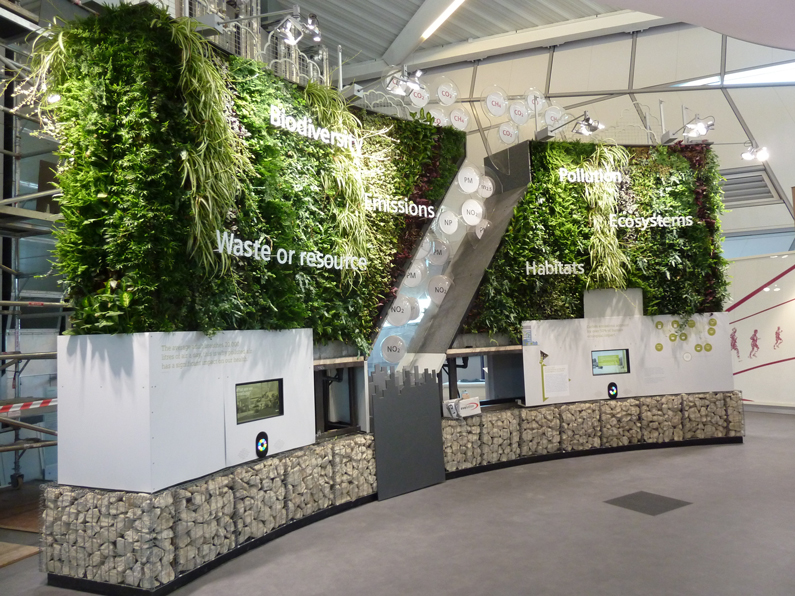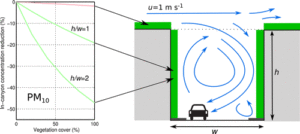
Grønne levende vegger fanger NO2 og PM (svevestøv) I langt større grad enn hva vi tidligere har kjent til. Dr A. Robert MacKenzie med flere fra Lancaster University har nylig publisert en forskningsrapport som presenterer meget gledelige nyheter for bymiljøet.
Effectiveness of Green Infrastructure for Improvement of Air Quality in Urban Street Canyons
Street-level concentrations of nitrogen dioxide (NO2) and particulate matter (PM) exceed public health standards in many cities, causing increased mortality and morbidity. Concentrations can be reduced by controlling emissions, increasing dispersion, or increasing deposition rates, but little attention has been paid to the latter as a pollution control method. Both NO2 and PM are deposited onto surfaces at rates that vary according to the nature of the surface; deposition rates to vegetation are much higher than those to hard, built surfaces.

Previously, city-scale studies have suggested that deposition to vegetation can make a very modest improvement (<5%) to urban air quality. However, few studies take full account of the interplay between urban form and vegetation, specifically the enhanced residence time of air in street canyons.
This study shows that increasing deposition by the planting of vegetation in street canyons can reduce street-level concentrations in those canyons by as much as 40% for NO2 and 60% for PM. Substantial street-level air quality improvements can be gained through action at the scale of a single street canyon or across city-sized areas of canyons. Moreover, vegetation will continue to offer benefits in the reduction of pollution even if the traffic source is removed from city centers. Thus, judicious use of vegetation can create an efficient urban pollutant filter, yielding rapid and sustained improvements in street-level air quality in dense urban areas.
Kilde:
Thomas A. M. Pugh *, A. Robert MacKenzie , J. Duncan Whyatt , and C. Nicholas Hewitt
Lancaster Environment Centre, Lancaster University, Lancaster, U.K., LA1 4YQ
Publication Date (Web): June 4, 2012
Utdragene nedenfor er hentet fra «Health & Green – living and working with plants»
Existing research about plants cleaning the indoor air of toxins (VOCs)
- Meanwhile research in Norway found that air in schools was cleaner once plants were introduced. Plants used in this research project by Professor Tove Fjeld (pronounced Tovay Feld), University of Agriculture, Oslo (1998) were: Aglaonema commutatum, Epipremnum aureum (Scindapsus aureum) and Dracaena deremensis.
- Professor Margaret Burchett, University of Technology, Sydney commented on interim research results last year (2009) finding that all plants work in the same way i.e. all plants remove toxins from the air.
Existing research about O2 and CO2 exchange between man and plants
- Andrew Smith, School of the Built Environment, John Moores University, Liverpool (2008) found that plants reduced CO2 by 50% in a planted open plan office
Existing research about plants reducing absenteeism
- Prof Tove Fjeld’s (University of Agriculture, Oslo, Norway 1996 – 2002) research in Norway in an office, schools and the x-ray department of a hospital all showed that with plants present both complaints about minor ailments often linked to Sick building syndrome and absenteeism were reduced
- Tina Bringslimark’s, (University of Agriculture, Oslo, Norway 2008) study also in Norway found that there was less self-reported sickness when plants could be seen from delegates’ desks
- Andrew Smith’s (School of the Built Environment, John Moores University, Liverpool 2008) study (UK) found that absenteeism was reduced by 50% in a planted office
Plants reduce stress levels
- Professor Virginia Lohr, Washington State University, USA (1996) found that plants reduced the physical signs of stress i.e. blood pressure, pulse rates and skin conductivity
- Prof Roger Ulrich, Texas A & M University, USA (1984, 91, 92, 99 & 2001) found that plants or even green views decreased stress levels of recovering surgical patients assisting faster recovery
- Tina Bringslimark, University of Agriculture, Oslo, Norway (2008) found that office workers reported less stress related sickness when they saw several plants from their desks
- Prof Margaret Burchett, University of Technology, Sydney, Australia 2010 found that even one plant made a difference to mood reducing anxiety, stress and depression
Plants increase concentration, performance, motivation, productivity, mood etc
- Prof Virginia Lohr, Washing State University, USA (1996) found that people working with plants in the room were as much as 12% more productive
- Prof Tove Fjeld’s (University of Agriculture, Oslo, Norway 1997) installation of plants in the x-ray department of Oslo radiology hospital reduced tiredness/exhaustion and improved worker output; planted classrooms afforded an increase in student concentration of 23%
The effect of plants on our creativity
- Prof Roger Ulrich, Texas A & M University, USA (2008) found that plants and flowers had a positive effect – +15% – on our creativity
How plants affect our well-being in various settings
Hospitals
- Prof Tove Fjeld’s (University of Agriculture, Oslo, Norway 1997) installation of plants in the x-ray department improved air quality and reduced minor sickness ailments as well as reducing absenteeism by 60%
Schools & colleges
- Prof Tove Fjeld, University of Agriculture, Oslo, Norway (1996 + 1998) found that plants in schools cleaned the air, lessened minor ailments linked to SBS, reduced stress, didn’t irritate or cause asthma
- Amanda Read, Royal College of Agriculture, Cirencester (2005) showed that students were more attentive and more likely to attend lectures in planted rooms
Shopping Centres
- Jorn Viumdal, University of Agriculture, Oslo, Norway (mid 1990s) found that shoppers stayed an average of 20 – 25 minutes longer in planted centres
- Kathleen Wolf’s (Washington State University 2002) study showed that the perception of plants outside of shops in the Mall gave them a perceived high class image
Green spaces
- Nancy Wells, Cornell College of Human Ecology, University of Michigan (2002) showed that children brought up in greener surroundings had better cognitive ability and concentration
The effect of plants on our indoor atmosphere
- Engelbert Kotter, Bavarian State Institute of Viticulture and Horticulture (2002) – plants raise humidity and comfort perception levels
- Hensler, Stutgart 1992 – plants return 90+% of the water we give them, back into the air
- Peter Costa, South Bank University, London (1995) – plants absorb noise
Other benefits of plants
- Craig Knight, University of Exeter (2009) showed evidence that enriched work environments can improve productivity by more than 15%. If the employees themselves had a say in the enrichment, then productivity improved by as much as 30%
Kilde:
HEALTH & GREEN – LIVING AND WORKING WITH PLANTS
Collected research about the benefits plants can bring to the work environment
EILO Congress, 2 November 2010



